Monstera Indoor Plant Care Guide
This comprehensive guide covers everything you need to know about caring for a Monstera deliciosa, from its botanical origins and basic care requirements to advanced topics like propagation, variegation, and troubleshooting common issues. Use the links below to jump to a specific section.
Introduction
With its iconic, perforated leaves, the Monstera deliciosa is a popular houseplant. Google Trends analysis shows Monstera is the most-searched-for houseplant in 16 U.S. states, including California, New York, and Ohio. 1 Its sculptural form adds a tropical element to home decor. 3
Botanical Overview & Naming
The plant's scientific name is Monstera deliciosa . The genus name, Monstera , likely comes from the Latin word monstrum ("monster"), referring to its large, unusual leaves. 4 The species name, deliciosa (Latin for "delicious"), refers to the edible, pineapple-and-banana-flavored fruit it produces in its native habitat (rarely indoors). 4
Monstera is in the Araceae family, making it a relative of philodendrons, pothos, and peace lilies. 6, 9 This family connection explains shared characteristics, such as growth habits and toxicity. Common names can cause confusion:
- [swiss cheese plant vs monstera] : "Swiss Cheese Plant" is a nickname, not a formal classification. It is most often applied to Monstera deliciosa but is also used for other species with leaf holes, such as Monstera adansonii . 10
- [split-leaf philodendron vs monstera] : Monstera deliciosa is not a philodendron, though it is often mislabeled as a "Split-Leaf Philodendron." 13 While both are in the Araceae family, they are in different genera. 15 The plant sometimes called a Split-Leaf Philodendron is Thaumatophyllum bipinnatifidum . 15 You can distinguish them by their leaves: a mature Monstera has splits and enclosed holes (fenestrations), while a Thaumatophyllum has deep lobes but no holes. 18 This distinction is important for proper care.
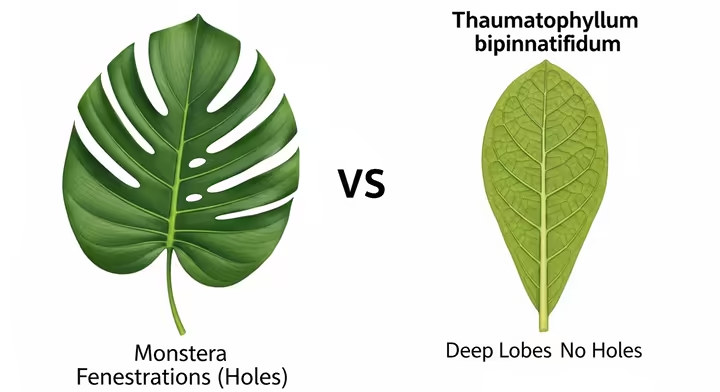
Native Habitat & Indoor Suitability
Monstera deliciosa is native to the wet tropical rainforests of Central America, from southern Mexico to Panama. 13 It grows as a hemiepiphyte—a climbing vine that starts on the forest floor and uses aerial roots to climb trees toward the filtered sunlight of the canopy. 5, 6 In the wild, it can grow up to 70 feet tall. 13
[is monstera an indoor plant] This evolutionary background makes Monstera well-suited for indoor growing. It is adapted to the dappled light, high humidity, and loose substrate of the forest understory, which are conditions that can be replicated in a home. Understanding its native environment provides a blueprint for its care.
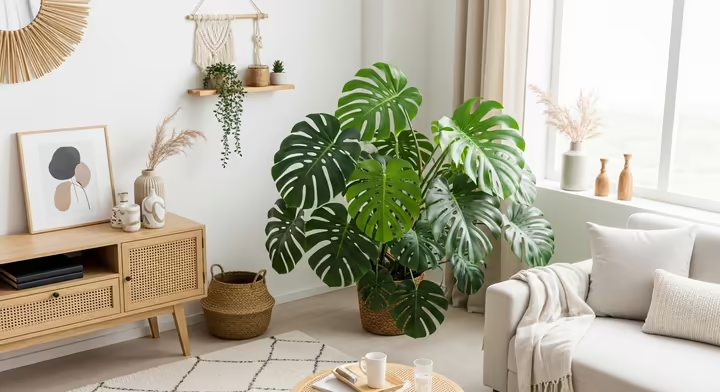
The Monstera Care Guide
Light
Light levels directly influence a Monstera's growth rate, leaf size, and the development of leaf holes (fenestrations).
- Ideal Light: Provide bright, indirect light . 22 An east-facing window is ideal. A spot several feet from a south- or west-facing window, or light filtered by a sheer curtain, also works well. 13 This exposure mimics the dappled sunlight of its native habitat. 17
- Too Much Light: Prolonged, direct sunlight will scorch the leaves, causing yellow or brown burn patches. 13
- [can monstera survive in low light] : A Monstera can tolerate low light, but it will not thrive. Insufficient light causes legginess (etiolation), where stems stretch and have large gaps between leaves. 25 It also prevents the development of fenestrations, resulting in only small, solid leaves. 13
Watering
Water based on the soil's moisture level, not a fixed schedule.
- [how often should i water my monstera] : Watering frequency depends on the season, light, temperature, humidity, and pot size. A weekly schedule is only a rough guideline. 28
- The "Soak and Dry" Method: Water thoroughly until it flows from the drainage holes, ensuring the entire root ball is saturated. Then, allow the top 2 to 3 inches (5 to 7.5 cm) of soil to dry out completely before watering again. 29 Check by inserting your finger into the soil. This cycle mimics the heavy but infrequent rainfall of its native environment.
- Signs of Trouble:
- Overwatering: Symptoms include yellowing lower leaves, soft or mushy stems near the base, and persistently soggy soil, which can lead to root rot. 28
- Underwatering: Symptoms include drooping leaves, brown and crispy leaf edges, and soil pulling away from the sides of the pot. 30 The plant usually recovers quickly after watering.
Soil
Standard potting mix is often too dense and retains too much water. Aroids like Monstera need a chunky, airy mix that provides moisture retention and excellent drainage, similar to the forest floor. 13 Making your own is easy and effective.
- [best soil for monstera] The Ideal Aroid Mix Recipe: Combine the following ingredients in roughly equal parts for a balanced mix.
- 1 Part Base Medium (e.g., Coco Coir or Peat Moss): Retains moisture and nutrients. Coco coir is a more sustainable alternative to peat moss. 33
- 1 Part Aeration (e.g., Orchid Bark or Coco Husks): Creates large air pockets to prevent compaction and allow oxygen to reach the roots, preventing root rot. 33
- 1 Part Drainage (e.g., Perlite or Pumice): Lightweight volcanic material that allows excess water to drain away quickly. 34
- Optional Additive (e.g., Horticultural Charcoal): A small amount can absorb impurities and excess moisture. 37
A well-draining soil mix is critical for making the "soak and dry" watering method effective and safe, as it dramatically reduces the risk of root rot.
Temperature & Humidity
As tropical plants, Monsteras require warmth and humidity.
- Temperature: The ideal range is 65°F to 85°F (18°C to 30°C) . 39 Growth slows below 50°F (10°C), and they are not frost-tolerant. 13 Keep them away from cold drafts and direct air conditioning blasts.
- Humidity: Monsteras prefer high humidity, ideally 60% or higher . 39 Low humidity can cause brown, crispy leaf tips. To increase humidity, you can:
- Group plants together.
- Place the pot on a tray of pebbles and water (ensure the pot is not sitting in the water).
- Use a small humidifier near the plant (most effective method). 42
-
[should I mist my monstera] The Misting Debate:
Myth Busted: Misting is largely ineffective and potentially harmful. It only provides a temporary humidity boost and can promote the spread of fungal and bacterial diseases if water sits on the leaves. 43, 44 Using a humidifier to provide consistent ambient humidity is a safer and more effective approach.
Fertilizing
Provide nutrients during the growing season to support new growth. 46
- What to Use: A balanced, all-purpose liquid houseplant fertilizer is a good choice. Use one with a balanced N-P-K ratio (e.g., 20-20-20) or one slightly higher in nitrogen (e.g., 3-1-2) to promote leaf growth. 46
- How and When: Fertilize every 2 to 4 weeks during the active growing season (spring and summer). 47 Dilute the fertilizer to half the recommended strength to avoid root burn. 49 Always apply to moist soil, never dry soil, to prevent root damage. 47
- When to Stop: Stop fertilizing in fall and winter when growth slows. 46 Fertilizing a dormant plant can cause mineral salts to build up in the soil, which can burn roots. 49 To prevent this, flush the soil every few months by letting a large volume of water run through the pot.
Support & Training
Providing support is essential for encouraging mature growth, resulting in larger leaves with more fenestrations.
- [how do I make my monstera climb] The Importance of a Pole: A moss pole or coir totem is the best support. 13 It provides a textured, moisture-retentive surface that the plant's aerial roots can grow into, mimicking a tree trunk. 50 This signals to the plant that it is secure, encouraging it to produce larger, mature leaves.
- How to Train It:
- Insert the Pole: Add a pole during repotting to avoid damaging the roots. Place it firmly at the back of the pot. 50
- Identify the Back: A Monstera has a "front" where leaves face and a "back" where aerial roots emerge. Position the back of the plant against the pole. 51
- Secure the Stem: Use soft plant ties or twine to gently tie the main stem to the pole. Only tie the thick main stem, never the slender leaf stalks (petioles) , as this can damage them. 50
- Encourage Attachment: Keep the moss pole moist by misting it or pouring water down it. This will encourage the aerial roots to grow into the pole. 50
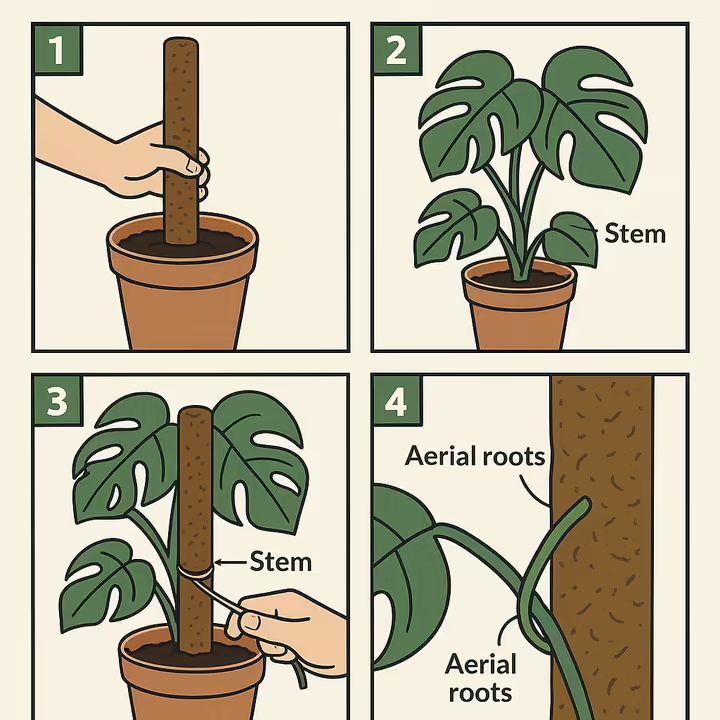
Potting & Repotting
Repotting provides fresh soil and more room for roots, which is essential for continued growth.
- [when should I repot my monstera] Signs It's Time to Repot:
- Roots are growing out of the pot's drainage holes. 52
- Roots are circling the soil surface or the pot is densely filled with roots.
- The plant is drying out much faster than usual. 53
- Growth has slowed or stopped during the growing season. 53
- Young plants may need repotting every 1-2 years; mature plants every 2-3 years. 52
- The Repotting Process:
- Timing: The best time to repot is in the spring. Water the plant a day or two before to reduce stress and make removal easier. 52, 55
- Choose the Right Pot: Select a new pot that is only 2 to 3 inches (5 to 7.5 cm) larger in diameter than the old one. 54 A pot that is too large holds excess moisture and can lead to root rot. 56 Ensure the pot has drainage holes.
- Remove and Inspect: Gently remove the plant from its pot. Healthy roots are firm and whitish. Using sterile pruners, trim any roots that are black, brown, or mushy, as these are signs of root rot. 52 Gently loosen circling roots.
- Repot: Add a layer of fresh aroid mix to the new pot. Insert a support pole now if using one. Position the plant at the same depth as it was in its old pot. Fill around the root ball with fresh soil. 55
-
Aftercare:
Water thoroughly. Return the plant to its usual spot. Some wilting for a week or so is normal.Important Tip: Do not fertilize for at least 4 to 6 weeks after repotting, as fresh soil has nutrients and new roots are sensitive. 52
Understanding Monstera Growth & Varieties
Fenestrations (Splits & Holes)
The splits and holes in Monstera leaves, called fenestrations, indicate that a plant is maturing in good conditions.
- [monstera leaves not splitting] Why Leaves Don't Split: The most common reasons are immaturity and insufficient light . 27 A Monstera is typically two to three years old before it produces fenestrated leaves. 27 Even a mature plant will produce solid leaves if it doesn't get enough light.
- The Purpose of Fenestrations: Theories on their evolutionary purpose include:
- Light Capture: Holes in upper leaves may allow light to pass through to lower leaves, maximizing photosynthesis for the whole plant. 59, 61
- Storm Resistance: Holes reduce wind resistance, allowing wind and rain to pass through large leaves without tearing them. 24
- Water Funneling: Holes may help channel rainwater down to the plant's roots on the forest floor. 62
A leaf emerges with all the fenestrations it will ever have; it does not develop more as it ages. 24 Future leaves will have more splits if conditions improve.
Aerial Roots
The long, brown roots that grow from the stem are aerial roots. They are normal and serve important functions.
- Function: In the wild, these roots anchor the vine to trees and absorb moisture and nutrients from the air and tree bark. 63
- What to Do With Them:
- Guide Them: The best practice is to guide them into the pot's soil or onto a moss pole. In soil, they function as normal roots, providing stability and absorbing nutrients. 63
- Trim Them: It is safe to trim long or unruly aerial roots with clean scissors without harming an established plant. 63
- What Not to Do: Do not place aerial roots in a separate jar of water, as constant submersion can cause them to rot. 64
Growth & Size
[how big will my monstera get indoors] While wild plants can reach 70 feet (21 m), an indoor Monstera deliciosa with proper care and support will typically reach a height and spread of 6 to 9 feet (2 to 3 meters) . 21 Its size is determined by pot size, support structure, light, and nutrients, and it can be kept smaller by pruning.
Common & Variegated Varieties
While M. deliciosa is the most common, other varieties are available.
- Common Species Comparison:
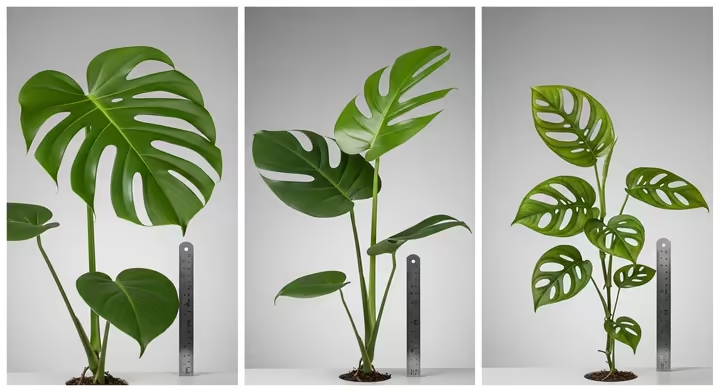
- Monstera deliciosa: The classic large-form Monstera . Its thick, leathery leaves have splits that run to the leaf edge.
- Monstera borsigiana: Often sold as deliciosa , this is a smaller, faster-growing form with a more vining habit and longer spaces between leaves. 69 A key difference is the geniculum (where the leaf joins the stalk): on borsigiana it is smooth, while on a true deliciosa it is wrinkled. 69
- Monstera adansonii: Known as the "Swiss Cheese Vine," this species has smaller, thinner leaves with oval holes that don't reach the edge. 10 Its trailing habit is suited for hanging baskets or small totems. 73
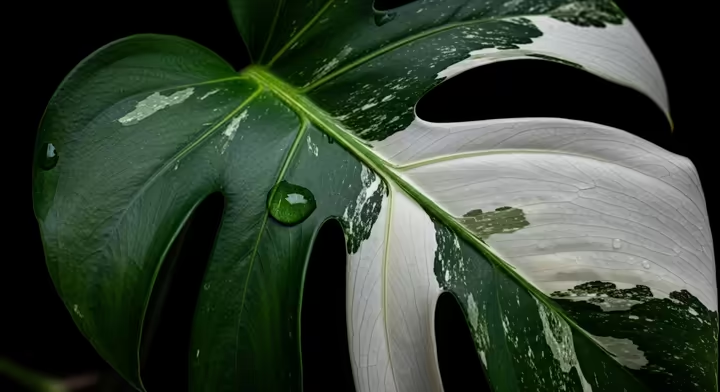
- Variegated Varieties
Variegation is a genetic mutation that causes some parts of the plant to lack chlorophyll, the green pigment for photosynthesis. 74 This creates white, cream, or yellow patterns. The lack of chlorophyll means these plants require special care.
- [variegated monstera care] Increased Care Needs: Because variegated sections cannot photosynthesize, these plants have less capacity to create energy. They require brighter indirect light than their green counterparts. 76 They are also slower-growing and more susceptible to sunburn, as the white tissue lacks protective pigment. 74
- Key Variegated Forms:
- Monstera deliciosa 'Albo Variegata' : The "Albo" has an unstable, chimeric mutation , resulting in random patches of pure white. 74 The pattern is unpredictable; a plant might produce a half-moon leaf, a mostly green leaf, or an all-white leaf (which will eventually die). This instability means it cannot be replicated by tissue culture, so it is propagated only by cuttings, making it rare and expensive. 80
- Monstera deliciosa 'Thai Constellation' : This variety has a stable mutation that produces a consistent, speckled pattern of creamy-white variegation. 75 Because the variegation is stable, it can be mass-produced via tissue culture (cloning), making it more available and affordable than the Albo . 80, 81
-
Ethical Sourcing:
Shop Ethically: High demand for rare plants has led to illegal poaching from the wild. Purchase rare varieties from reputable nurseries and sellers to ensure you receive a healthy, propagated plant and do not contribute to the depletion of wild populations. 83
Troubleshooting Common Problems
Problems that appear on leaves, like yellowing or browning, often indicate an issue with the roots or watering. When in doubt, check the soil and roots first.
| Symptom | Most Likely Cause(s) | Solution(s) |
|---|---|---|
| Yellow Leaves [monstera turning yellow] | Overwatering (most common), underwatering, nutrient deficiency, or normal aging of the oldest leaf. 86 | Check soil moisture. If wet, let it dry and water less often. Check for root rot. If dry, water thoroughly. Fertilize during the growing season if needed. |
| Brown, Crispy Tips/Edges | Low humidity (most common), underwatering, or mineral buildup from tap water or fertilizer. 30 | Increase humidity with a humidifier or pebble tray. Water consistently. Flush soil with distilled or filtered water to remove salts. |
| Drooping/Wilting Leaves | Underwatering (most common), overwatering (root rot prevents water absorption), or transplant shock. 91 | Check soil moisture. If dry, water thoroughly. If wet, check for root rot and repot if needed. If recently repotted, give it time to adjust. |
| No Fenestrations (Splits) [monstera leaves not splitting] | Insufficient light or the plant is too young (under 2-3 years old). 27 | Move to a location with brighter, indirect light. Be patient; fenestrations develop with maturity. |
| Leggy Growth | Insufficient light . The plant is stretching (etiolation) to reach a light source. 25 | Move to a brighter location or use a grow light. Prune leggy stems to encourage bushier growth; the cuttings can be propagated. |
| Brown/Black Spots on Leaves | Fungal/bacterial disease (often from water on leaves or overwatering), or sunburn (dry, tan spots). 95 | Improve air circulation. Water the soil, not the leaves. Stop misting. Remove affected leaves. Move plant out of direct sun. |
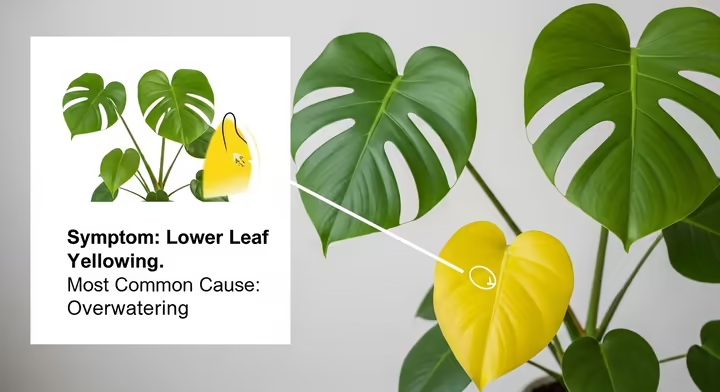
Pest & Disease Management
Pests can be managed by prioritizing prevention and using the least toxic treatments first (Integrated Pest Management). 97
- Prevention: Regularly inspect the tops and bottoms of leaves. Isolate new plants for a few weeks to ensure they are pest-free. Keep leaves clean and dust-free. 97, 98
- Common Pests and Treatments:
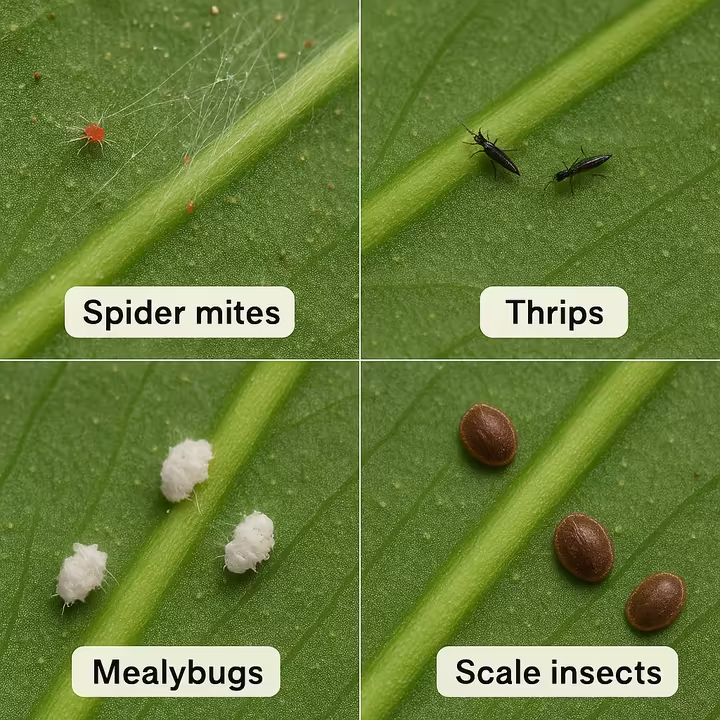
- Spider Mites: Look for fine webbing on the undersides of leaves and a stippled, faded leaf appearance. Treatment: Spray the plant with a strong jet of water. Follow with a thorough spray of insecticidal soap or horticultural oil. Repeat weekly until gone. 99
- Thrips: Tiny, slender black insects that leave silvery patches and tiny black specks on leaves. 100 Treatment: Use a lint roller to physically remove adults. Follow with repeated weekly treatments of insecticidal soap. For severe infestations, repotting in fresh soil can help. 100
- Mealybugs: Small, white, cottony masses that hide in leaf joints and stem crevices. Treatment: For small spots, touch mealybugs with a cotton swab dipped in 70% isopropyl alcohol. For larger infestations, spray with insecticidal soap or neem oil. 99
- Scale: Small, immobile brown bumps on stems and leaves, protected by a hard shell. Treatment: Manually scrape them off with a fingernail or a swab dipped in alcohol. For heavy infestations, use horticultural oil to smother them. 102
- Root Rot: This condition is caused by overwatering and poorly draining soil, which allow fungi and bacteria to attack the roots. 95 Symptoms include a wilting plant in moist soil, yellowing leaves, and a foul smell from the soil. 54 Treatment: This requires immediate action. Remove the plant from the pot and wash the roots. Using sterile scissors, trim off all black, brown, or mushy roots. Repot into a clean pot with fresh, well-draining aroid mix. Water sparingly until the plant shows signs of recovery.
Propagation: Creating New Monstera Plants
Propagating a Monstera is easy, but success depends on including a node in the cutting.
Propagating from a Stem Cutting
This is the most common and reliable method.
- [how do I propagate monstera cuttings] Step-by-Step Guide:
- Identify the Node: The node is the slightly swollen joint on the main stem where a leaf attaches and new growth originates. 103 An aerial root often emerges near a node. You must include at least one node in your cutting. A cutting of only a leaf and its stalk will not grow into a new plant because it lacks a node. 105
- Make the Cut: Using a clean knife or shears, cut the stem about an inch below a node. The cutting should have at least one leaf and one node. 107
- Choose Your Method: You can root the cutting in water or soil.
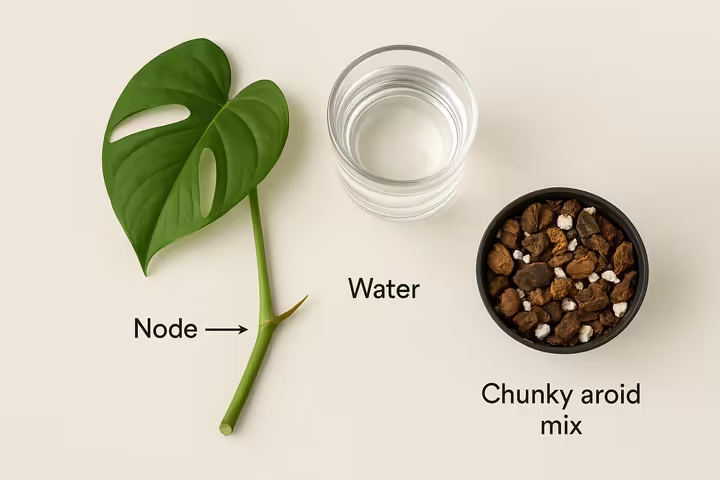
- Method 1: Water Propagation
- Process: Place the cutting in a clear jar of water, making sure the node is submerged but the leaves are out of the water. 103 Put the jar in bright, indirect light.
- Maintenance: Change the water every 3-5 days to keep it fresh and prevent rot. 103
- Potting: Once new roots are 2-4 inches (5-10 cm) long, transplant the cutting into a pot with soil. 107
- Method 2: Soil Propagation
- Process: Optionally dip the cut end in rooting hormone. Plant the cutting directly into a small pot with a moist, airy propagation mix, burying the node about an inch deep. 107
- Maintenance: Keep the soil moist but not waterlogged. Covering the pot with a plastic bag can maintain high humidity.
- Potting: The cutting is successfully rooted when you see new leaf growth or feel resistance when you gently tug it.
-
Water vs. Soil: Which is Better?
Each method has pros and cons.
- Water propagation allows you to see the roots grow. However, water-grown roots are more brittle and can experience transplant shock when moved to soil. 109, 112
- Soil propagation develops stronger, soil-adapted roots from the start, but you cannot see the progress and must maintain proper soil moisture to prevent rot. 113, 114
Air Layering: A Low-Risk Technique
Air layering allows you to root a stem while it is still attached to the parent plant, making it a nearly foolproof method.
- The Process:
- Locate a healthy stem with a node and an aerial root. 115
- Optionally, make a small, shallow cut about 1/3 through the stem just below the node to encourage rooting. 116
- Pack pre-moistened sphagnum moss firmly around the node. 108
- Wrap the moss ball securely with clear plastic wrap and seal it at the top and bottom. 116
- Keep the moss moist. You will see roots grow into the moss through the plastic over several weeks.
- Once a healthy root system has formed in the moss, cut the stem from the parent plant just below the new roots. Unwrap the plastic and plant your new, rooted Monstera . 115
Benefits, Safety, and Sustainability
Environmental & Psychological Benefits [swiss cheese plant benefits]
-
Air Purification: A Realistic Perspective
The most tangible benefit is the slight increase in humidity from transpiration. 118A Note on Air Purification: While often marketed as air purifiers based on a 1989 NASA study, houseplants have a minimal effect on air quality in a typical home. Replicating the study's results would require an impractically high density of plants, and it's primarily soil microbes, not leaves, that remove airborne compounds. 117, 120 -
Psychological Benefits (Biophilia)
The most significant benefit of living with plants is psychological. The Biophilia Hypothesis suggests humans have an innate need to connect with nature. 121 Studies show that interacting with indoor plants can:
- Reduce Stress: Lower blood pressure and cortisol levels. 124
- Improve Focus: Increase concentration and productivity by up to 15%. 123
- Boost Mood: Promote feelings of happiness and relaxation. 124
The primary benefit of a Monstera is its positive effect on mental well-being and its ability to foster a connection to nature.
Health & Toxicity Warning
[are monstera plants toxic to pets]
- Mechanism of Toxicity: The plant's tissues contain microscopic, needle-shaped crystals of insoluble calcium oxalate (raphides). 128
- Symptoms: Chewing the plant releases these sharp crystals, causing immediate and painful physical injury to the mouth, tongue, and throat. Symptoms include intense oral irritation, pain and swelling of the mouth and lips, drooling, vomiting, and difficulty swallowing. 130, 134
- Severity: Toxicity is generally mild to moderate. The immediate pain usually prevents ingestion of a large, life-threatening amount. 130 However, severe swelling can pose a breathing risk and may require veterinary care. 128 Place the plant safely out of reach of pets and small children.
Sustainability in Plant Ownership
- Choose Peat-Free Potting Mixes: Peat moss, a common ingredient in potting soils, is harvested from peat bogs—fragile ecosystems that are vital carbon sinks. 35 Harvesting peat releases large amounts of carbon dioxide and destroys wildlife habitats. 136 Choosing sustainable alternatives like coco coir, compost, and wood fiber is a better environmental choice. 138
- Source Plants Responsibly: The popularity of rare houseplants has fueled illegal plant poaching, which threatens wild populations. 84 Always buy from reputable nurseries that practice propagation. Buying cuttings or tissue-cultured plants from trusted sellers is a sustainable way to acquire rare varieties. 81 Be cautious of sellers offering large, rare plants at unusually low prices, as this can be a sign of wild harvesting. 84
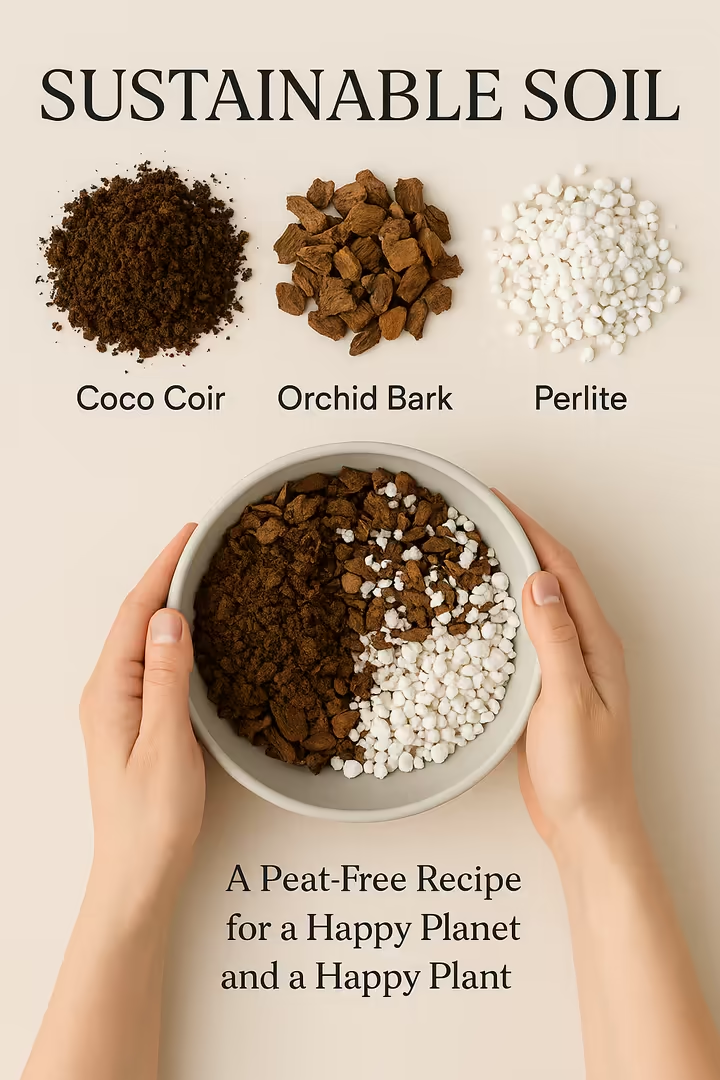
Frequently Asked Questions (FAQ)
Q1: Is a Monstera the same as a Split-Leaf Philodendron?
No. This is a common misnomer. While they are in the same plant family (Araceae), Monstera deliciosa is in a different genus from true philodendrons. The name "Split-Leaf Philodendron" is more accurately, though still informally, applied to Thaumatophyllum bipinnatifidum, which has deeply lobed leaves but no enclosed holes.
Q2: Why won't my Monstera's leaves split?
The two most common reasons are age and light. A Monstera needs to be mature (typically 2-3 years old) and receive consistent bright, indirect light to have enough energy to produce its signature fenestrated leaves. If your mature plant's new leaves are solid, it almost certainly needs more light.
Q3: How often should I really water my Monstera?
Ditch the schedule. Water your Monstera based on soil moisture, not the calendar. Water thoroughly until it drains from the bottom of the pot, then wait until the top 2-3 inches of soil are completely dry before watering again.
Q4: Are Monstera plants safe for my cat/dog?
No. All parts of the Monstera plant are toxic to cats and dogs if chewed or ingested. They contain sharp calcium oxalate crystals that cause immediate and painful oral irritation, swelling, and gastrointestinal distress. Keep the plant out of reach of pets.
Q5: What should I do with the long, brown aerial roots?
These roots are for climbing and absorbing moisture. The best practice is to gently guide them into the pot's soil or onto a moss pole, where they can provide support and nutrients. You can also trim them off with clean shears without harming a healthy plant.
Q6: Do I have to give my Monstera a moss pole?
You don't have to, but it is highly recommended. Providing a support structure like a moss pole encourages the plant's natural climbing habit, which in turn leads to stronger growth, larger leaves, and more impressive fenestrations.
Q7: What's the difference between a Monstera Albo and a Thai Constellation?
Both are variegated forms of M. deliciosa. The Albo has an unstable genetic mutation, producing random, sectoral patches of pure white. It can only be propagated by cuttings, making it rarer and more expensive. The Thai Constellation has a stable mutation, producing a consistent, speckled pattern of creamy-white. Its stability allows it to be mass-produced via tissue culture, making it more widely available.
Works cited
- US: "Monstera is the most popular houseplant" - FloralDaily, https://www.floraldaily.com/article/9421115/us-monstera-is-the-most-popular-houseplant/
- Most POPULAR U.S. Houseplants - State by State - Flower Power Daily, https://flowerpowerdaily.com/most-popular-u-s-houseplants-state-by-state/
- Monstera Hype 2025: Essential Insights - Nursery Near Me, https://nurserynearme.com.au/blogs/blog/monstera-hype-2025-essential-insights
- herbaria.plants.ox.ac.uk, https://herbaria.plants.ox.ac.uk/bol/plants400/Profiles/MN/Monstera#:~:text=(Araceae)&text=The%20name%20Monstera%20may%20derive,refers%20to%20the%20edible%20fruit.
- Monstera deliciosa - Oxford University Plants 400, https://herbaria.plants.ox.ac.uk/bol/plants400/Profiles/MN/Monstera
- Monstera - Wikipedia, https://en.wikipedia.org/wiki/Monstera
- Monstera deliciosa - USDA, https://acir.aphis.usda.gov/s/cird-taxon/a0ut0000002iNz3AAE/monstera-deliciosa
- Monstera deliciosa Liebm. - USDA Plants Database, https://plants.usda.gov/plant-profile/MODE
- What's the Difference Between Monstera and Split-Leaf Philodendron?, https://www.bhg.com/gardening/houseplants/projects/monstera-and-split-leaf-philodendron-difference/
- Swiss Cheese Philodendron vs. Monstera Plant? - The Greenery Nursery, https://greenerynsy.com/swiss-cheese-philodendron-vs-monstera-plant/
- en.wikipedia.org, https://en.wikipedia.org/wiki/Monstera_adansonii
- Monstera adansonii - Ecuagenera USA, https://ecuageneraus.com/products/monstera-adadsonii
- Swiss-Cheese Plant, Monstera deliciosa - Wisconsin Horticulture, https://hort.extension.wisc.edu/articles/monstera-deliciosa/
- mulhalls.com, https://mulhalls.com/garden-home/blog/a-closer-look-at-monstera-deliciosa/#:~:text=Monstera%20deliciosa%20is%20an%20epiphytic,the%20same%20genus%20as%20philodendrons.
- Split Leaf Philodendron vs. Monstera: What's The Difference? - Epic Gardening, https://www.epicgardening.com/philodendron-vs-monstera/
- What's in a (Scientific) Name? — The Zen Succulent | Low Maintenance Greenery At Your Doorstep, https://www.thezensucculent.com/blog/2018/6/18/whats-in-a-scientific-name
- Monstera Vs Split Leaf Philodendron: Similarities And Differences - Cozy Botanics, https://cozybotanics.com/monstera-vs-philodendron/
- #TuesdayTidbits Yes, There is a Difference - The Houseplant Guru, https://thehouseplantguru.com/2019/04/09/tuesdaytidbits-yes-there-is-a-difference/
- How to tell Monstera deliciosa from Philodendron bipinnatifidum - YouTube, https://www.youtube.com/watch?v=e7_8VQzuEpw
- Monstera deliciosa Liebm. | Plants of the World Online | Kew Science, https://powo.science.kew.org/taxon/urn:lsid:ipni.org:names:87478-1/general-information
- Monstera deliciosa (Swiss Cheese Plant) - Plant Care 101 - Gardenia.net, https://www.gardenia.net/plant/monstera-deliciosa-swiss-cheese-plant
- Monstera deliciosa (Ceriman, Cutleaf Philodendron, Hurricane Plant, Mexican Breadfruit, Split-leaf Philodendron, Swiss Cheese Plant), https://plants.ces.ncsu.edu/plants/monstera-deliciosa/
- Dakota Gardener: Monstera maintenance — Extension and Ag Research News, https://www.ag.ndsu.edu/news/columns/dakota-gardener/dakota-gardener-monstera-maintenance
- Monstera Deliciosa | Plant Care | LiveTrends Design Group, https://livetrends.com/plant-care/monstera-deliciosa/
- How to Fix Your Monstera Growing Too Tall and Thin? 5 Expert Tips to – Glowrium, https://www.glowrium.com/blogs/news/%F0%9F%8C%BFhow-to-fix-your-monstera-growing-too-tall-and-thin-5-expert-tips-to-reshape-it
- Fix Leggy Monstera Deliciosa, https://leafypixels.com/blog/fix-leggy-monstera-deliciosa/
- Why Is My Monstera Not Growing Split Leaves? - Gardening Know How, https://www.gardeningknowhow.com/houseplants/monstera-not-growing-split-leaves
- How Often to Water Monstera So It Thrives for Decades - Martha Stewart, https://www.marthastewart.com/how-often-to-water-monstera-8733332
- How Much and How Often to Water a Monstera: What You Need to Know - The Spruce, https://www.thespruce.com/how-often-to-water-monstera-8606928
- A Full Guide on How Often to Water Monstera - Spider Farmer EU, https://spiderfarmer.eu/blog/how-much-amp-how-often-to-water-monstera/
- 6 Signs You're Underwatering Your Houseplants — Especially in the Heat of Summer, https://www.livingetc.com/advice/signs-of-underwatered-houseplants
- Monstera Deliciosa help.... | UBC Botanical Garden Forums, https://forums.botanicalgarden.ubc.ca/threads/monstera-deliciosa-help.34382/
- The Best DIY Chunky Soil Mix for Aroids - Cori Sears, https://corisears.ca/diy-chunky-soil-mix-for-aroids/
- DIY Aroid Soil Mix: 4 Ingredients for the Perfect Aroid Potting Mix (Monstera Potting Mix + More), https://monsteramash.com/diy-aroid-soil-potting-mix/
- The Peat Report: A Case Against Canadian Peat Moss - Greenhouse Grower, https://www.greenhousegrower.com/production/media/the-peat-report-a-case-against-canadian-peat-moss/
- A Case Against Peat | Fulton From the Ground Up - UGA, https://site.extension.uga.edu/fultonag/2021/06/a-case-against-peat/
- General aroid mix recipe - WeLoveIndoorPlants, https://weloveindoorplants.com/2023/06/general-aroid-mix-recipe/
- My DIY Aroid Soil Mix Recipe - Hoya Treasures, https://hoyatreasures.com/blogs/houseplant-care/my-diy-aroid-soil-mix-recipe
- www.thespruce.com, https://www.thespruce.com/how-to-grow-monstera-deliciosa-5072671#:~:text=Monstera%20deliciosa%20grows%20best%20in%20temperatures%20between%2065%C2%B0F,humidity%20indoors%2C%20add%20a%20humidifier.
- Indoor Monstera Deliciosa Care Guide for Beginners - INKBIRD, https://inkbird.com/blogs/growing/monstera-care-guide
- How to Care for Monstera Deliciosa - easyplant, https://easyplant.com/care/monstera-deliciosa
- Monsteras and Moisture: Do Monsteras Like Humidity and Misting?, https://monsteraplantresource.com/monsteras-and-moisture-do-monsteras-like-humidity-and-misting/
- Is it useful to mist houseplants? - l'application Monstera, https://www.monstera-app.com/en/blog/care-tips/should-houseplants-be-misted-01G0MG8GX4T4SV8MGB139TCRZH
- Why you mist your monstera and why you don't? - Reddit, https://www.reddit.com/r/Monstera/comments/u56lro/why_you_mist_your_monstera_and_why_you_dont/
- To mist or not to mist : r/houseplants - Reddit, https://www.reddit.com/r/houseplants/comments/frl05q/to_mist_or_not_to_mist/
- Fertilizing Monstera - Plant Addicts, https://plantaddicts.com/fertilizing-monstera/
- The Best Fertilizer For Monsteras — Plant Care Tips and More - La Résidence, https://blog.leonandgeorge.com/posts/best-fertilizer-for-monsteras
- Monstera Care Guide - Lively Root, https://www.livelyroot.com/pages/monstera-care-guide
- Monstera Plant Care: Common Fertilizing Mistakes To Avoid, https://xanhxanhurbanforest.com/monstera-plant-care-fertilizing-mistakes/
- Learn How to Use a Moss Pole for Monstera and Why - Lively Root, https://www.livelyroot.com/blogs/plant-care/moss-pole-for-monstera
- Need advice on how/where to add a moss pole to my monstera. : r/houseplants - Reddit, https://www.reddit.com/r/houseplants/comments/tlvrf7/need_advice_on_howwhere_to_add_a_moss_pole_to_my/
- How to Repot a Monstera in 7 Easy Steps - The Spruce, https://www.thespruce.com/how-to-repot-a-monstera-7504767
- 7 Signs it's Time to Repot Your Monstera Plant - Epic Gardening, https://www.epicgardening.com/repot-monstera-signs/
- Monstera Deliciosa Repotting Signs: A Comprehensive Guide, https://xanhxanhurbanforest.com/monstera-deliciosa-repotting-signs/
- Learn How to Repot Monstera: A Beginner's Guide, https://www.livelyroot.com/blogs/plant-care/repotting-monstera
- Monstera Deliciosa Care: A Complete Guide - Here She Grows, https://hereshegrows.com/2025/01/05/monstera-deliciosa/
- Why Your Monstera's Leaves Aren't Splitting - Happy Plant, https://www.happyplantclub.com/blogs/plants/why-your-monsteras-leaves-arent-splitting
- Why do the new leaves not have holes/splits? : r/Monstera - Reddit, https://www.reddit.com/r/Monstera/comments/1dggfvv/why_do_the_new_leaves_not_have_holessplits/
- The Fascinating World of Monstera Fenestration: A Guide to its Unique Leaf Patterns, https://cafeplanta.com/a/blog/the-fascinating-world-of-monstera-fenestration-a-guide-to-its-unique-leaf-patterns
- If the holes in the leaf come as a result of the age of the monstera, then why don't all new leaves have the holes? The middle leaf in this photo unfurled recently. We can confirm it is one plant. We just repotted it and we're surprised. - Reddit, https://www.reddit.com/r/Monstera/comments/tvt2py/if_the_holes_in_the_leaf_come_as_a_result_of_the/
- Truth about Monstera leaves and their holes - Cambridge Bee, https://www.cambridgebee.com/blogs/news/the-holly-truth-of-monstera-leaves-with-holes
- The adaptive function of leaf fenestrations in Monstera spp (Araceae) a look at water, wind, and herbivory, May 2011 - Digital Commons @ USF - University of South Florida, https://digitalcommons.usf.edu/cgi/viewcontent.cgi?article=1078&context=tropical_ecology
- Managing Aerial Roots on Monstera Plants: Tips for a Healthy Plant, https://www.plantlovers.eu/blogs/care-and-maintenance/managing-aerial-roots-on-monstera-plants-tips-for-a-healthy-plant
- Monstera Aerial Roots: 7 Things to Know About Them - The Spruce, https://www.thespruce.com/monstera-aerial-roots-6828242
- Monstera Aerial Roots: Everything You Need to Know - Cori Sears, https://corisears.ca/monstera-aerial-roots/
- What to do with your Monstera aerial roots - YouTube, https://www.youtube.com/watch?v=sasEKn4OqGg
- haltonmastergardeners.com, https://haltonmastergardeners.com/2022/10/30/my-favourite-houseplant-the-monstera-deliciosa/#:~:text=In%20temperate%20climates%20the%20Monstera,will%20produce%20an%20edible%20fruit.
- How to Care for Monstera Plants - A Beautiful Mess, https://abeautifulmess.com/how-to-care-for-monstera-plants/
- Monstera Deliciosa Vs Borsigiana (Differences and Similarities), https://xanhxanhurbanforest.com/monstera-deliciosa-vs-borsigiana/
- How To Identify if your Monstera's a Deliciosa or Borsigiana - YouTube, https://www.youtube.com/watch?v=2XL2Ynpjl8U
- How you know if it's a Monstera Borsigiana or Deliciosa - YouTube, https://www.youtube.com/shorts/-IP1pJBG_zY
- Deliciosa VS Borsigiana Monstera | They're VERY Different - Which One is Yours?, https://m.youtube.com/shorts/rY_MaYS7VFw
- Monstera Confusion: Cheese Plant vs. Adansonii vs. Obliqua 'Peru' – Wh, https://www.happyhouseplants.co.uk/blogs/houseplant-blog/monstera-confusion-cheese-plant-vs-adansonii-vs-obliqua-peru-what-s-the-difference
- Variegated Monsteras – which is which? – House Plant Jungle, https://houseplantjungle.com.au/variegated-monsteras-which-is-which/
- Monstera Variegated - UPshining, https://www.upshining.com/pages/rare-plants
- Variegated Monstera Care Guide - Quirky Plants, https://www.quirkyplants.co.uk/blogs/plant-care-guides/variegated-monstera-care-guide
- Variegated Monstera Care - Greenery Unlimited, https://greeneryunlimited.co/pages/variegated-monstera-care
- Variegated Monstera - Plants For All Seasons, https://www.plantsforallseasons.co.uk/pages/variegated-monstera
- Care Guide: Unleash the Beauty of the extra white Monstera Variegata - Plantlovers, https://www.plantlovers.eu/blogs/care-and-maintenance/care-guide-unleash-the-beauty-of-the-extra-white-monstera-variegata
- I'm having a hard time understanding the different variegation types, is there a chart that shows the differences? : r/Monstera - Reddit, https://www.reddit.com/r/Monstera/comments/13g95kr/im_having_a_hard_time_understanding_the_different/
- Monstera Thai Constellation Tissue Culture - Orange Lake Nursery, https://orangelakenursery.com/products/monstera-thai-constellation-plantlet-1
- Grow Monstera Thai Constellation Tissue Culture: A Complete Guide - Greenboog's, https://greenboog.com/grow-monstera-thai-constellation-tissue-culture-a-complete-guide/
- Sourcing: Ethical, Sustainable, Beneficial - Mental Houseplants, https://mentalhouseplants.com/pages/sourcing
- How can you ensure your online plant purchases are ethical, legal, and sustainable? - TRAFFIC - The Wildlife Trade monitoring network, https://www.traffic.org/views/how-can-you-ensure-your-online-plant-purchases-are-ethical-legal-and-sustainable/
- How concerned are you about the ecological impacts and ethical sourcing of houseplants?, https://www.reddit.com/r/houseplants/comments/113yw62/how_concerned_are_you_about_the_ecological/
- Some of the leaves on my plants are turning yellow. What is causing this? | Mississippi State University Extension Service, http://extension.msstate.edu/content/some-the-leaves-my-plants-are-turning-yellow-what-causing
- Why Are My Monstera Leaves Turning Yellow? - The Spruce, https://www.thespruce.com/monstera-leaves-turning-yellow-7151519
- Why is My Monstera Plant Turning Yellow? Common Causes and Solutions, https://bloomboxusa.com/blogs/news/why-is-my-monstera-plant-turning-yellow
- Tips to avoid Brown Leaves on Monstera - YouTube, https://www.youtube.com/watch?v=3nOxyq12lYY
- Monstera tips brown and crispy - House Plant Journal, https://www.houseplantjournal.com/houseplant-qa/monstera-tips-brown-and-crispy/
- Droopy Monstera | How to Fix, https://monsteraplantresource.com/droopy-monstera-how-to-fix/
- Why are the leaves on my Monstera limp and drooping? - Bloomscape, https://bloomscape.com/common-issue/why-are-the-leaves-on-my-monstera-limp-and-drooping/
- 3 Reasons Why Your Monstera Is Droopy and How to Fix It - The Spruce, https://www.thespruce.com/reasons-why-monstera-is-droopy-7481857
- Why Your Houseplants Look Leggy (and How to Fix This Common Problem) - Treleaf, https://treleaf.shop/blogs/news/why-your-houseplants-look-leggy-and-how-to-fix-this-common-problem
- Monstera deliciosa | Home and Garden Education Center, https://homegarden.cahnr.uconn.edu/factsheets/monstera-deliciosa/
- Monstera Plant Care: Dealing with Brown Leaves from Overwatering - TikTok, https://www.tiktok.com/@purivedplantfood/video/7223869227927653674
- Houseplant Problems - UC IPM, https://ipm.ucanr.edu/home-and-landscape/houseplant-problems/
- Houseplant Insect Control | Extension Store, https://store.extension.iastate.edu/product/Houseplant-Insect-Control-PDF
- Managing Houseplant Pests - CSU Extension, https://extension.colostate.edu/docs/pubs/insect/05595.pdf
- Thrips on Houseplants: A Gallery - House Plant Journal, https://www.houseplantjournal.com/thrips/
- How to Get Rid of Mealybugs: 8 Easy Methods - The Spruce, https://www.thespruce.com/how-to-control-mealybugs-1902890
- How to Get Rid of Scale on Plants - The Spruce, https://www.thespruce.com/how-to-get-rid-of-scale-insects-1402693
- Good to Know: How to Propagate a Monstera (and other care tips) - CARMEON HAMILTON, https://carmeonhamilton.com/blog/2019/03/good-to-know-how-to-propagate-monstera.html
- How to Propagate Monstera Deliciosa: A Complete Beginner's Guide, https://stage.dance.washington.edu/how-to-propagate-monstera-deliciosa-a-complete-beginners-guide/
- Propagating Monstera deliciosa - University of Minnesota Extension, https://extension.umn.edu/houseplants/propagating-monstera-deliciosa
- Propagation & Monstera Plant Resource Center, https://monsteraplantresource.com/category/propagation/
- How to Propagate Monstera Deliciosa - The Spruce, https://www.thespruce.com/how-to-propagate-monstera-7113171
- How to Propagate a Monstera - A Complete Illustrated Guide - Lively Root, https://www.livelyroot.com/blogs/plant-care/how-to-propagate-a-monstera
- My Guide to Propagating Monstera Plants at Home - Randy Lemmon, https://randylemmon.com/my-guide-to-propagating-monstera-plants-at-home/
- How to propagate : r/Monstera - Reddit, https://www.reddit.com/r/Monstera/comments/178w7e3/how_to_propagate/
- Propagate Monstera in Water or Soil! - Flower Patch Farmhouse, https://www.flowerpatchfarmhouse.com/propagate-monstera/
- Just propagated my monstera! should i put it in water or dirt? : r/proplifting - Reddit, https://www.reddit.com/r/proplifting/comments/l2eaq0/just_propagated_my_monstera_should_i_put_it_in/
- Can I plant this straight in soil? : r/Monstera - Reddit, https://www.reddit.com/r/Monstera/comments/1eq5fwy/can_i_plant_this_straight_in_soil/
- Propagating Monstera In Water | An Easy Guide, https://monsteraplantresource.com/propagating-monstera-in-water-an-easy-guide/
- How to Propagate Monstera for an Endless Supply of Greenery, According to Horticulturists, https://www.marthastewart.com/how-to-propagate-monstera-8779509
- How to Propagate by Air Layering and Simple Layering | Yard and Garden, https://yardandgarden.extension.iastate.edu/how-to/how-propagate-houseplants-air-layering-and-simple-layering
- NASA Clean Air Study - Wikipedia, https://en.wikipedia.org/wiki/NASA_Clean_Air_Study
- Monstera: The Air-Purifying Powerhouse for Your Home - Cambridge Bee, https://www.cambridgebee.com/blogs/news/monstera-the-air-purifying-powerhouse-for-your-home
- Debunking NASA study on air-cleaning plants - Garden Bite, https://gardenbite.com/debunking-nasa-study-on-air-cleaning-plants/
- NASA Plant Research Offers a Breath of Fresh Air, https://spinoff.nasa.gov/Spinoff2019/cg_7.html
- biofilico.com, https://biofilico.com/news/air-purifying-plants-healthy-biophilic-interiors#:~:text=The%20concept%20of%20biophilia%20suggests,increasing%20feelings%20of%20well%2Dbeing.
- The Biophilia Hypothesis: Why Plants Belong in Your Home & Business, https://rizaplants.com/blogs/news/the-biophilia-hypothesis-why-plants-belong-in-your-home-business
- Biophilia & Research - Benefits of Indoor Plants, https://www.ieqindoorplants.com.au/biophilia-research-benefits-indoor-plants/
- The Health Benefits of Biophilia Plants in Interiors — wellness design consultants - Biofilico, https://biofilico.com/news/air-purifying-plants-healthy-biophilic-interiors
- Biophilia: Does Visual Contact with Nature Impact on Health and Well-Being? - PMC, https://pmc.ncbi.nlm.nih.gov/articles/PMC2760412/
- Effects of Indoor Plants on Human Functions: A Systematic Review with Meta-Analyses, https://pmc.ncbi.nlm.nih.gov/articles/PMC9224521/
- Pet Safe Plants - Toxic to Pets Houseplants - Gardens of Babylon Landscapes, https://gardensofbabylon.com/pets-plants-whats-safe-whats-not/
- Four Common Houseplants that are Toxic to Cats and Dogs - Animal Emergency & Referral Center of Minnesota, https://aercmn.com/four-common-houseplants-that-are-toxic-to-cats-and-dogs/
- Toxic and Non-Toxic Plant List - Dogs - ASPCA, https://www.aspca.org/pet-care/animal-poison-control/dogs-plant-list
- Plants That Irritate - Children's Hospital of Philadelphia, https://www.chop.edu/centers-programs/poison-control-center/plants-irritate
- Raphide - Wikipedia, https://en.wikipedia.org/wiki/Raphide
- Fruit salad plant (Monstera deliciosa) | Queensland Poisons Information Centre, https://www.poisonsinfo.health.qld.gov.au/plants-and-mushrooms/fruit-salad-plant-monstera-deliciosa
- Calcium oxalate crystals, Exotic Rainforest rare tropical plants, https://www.exoticrainforest.com/Calcium%20oxalate%20crystals.html
- Ceriman | ASPCA, https://www.aspca.org/pet-care/animal-poison-control/toxic-and-non-toxic-plants/ceriman
- How toxic to cats is a Monstera really? : r/houseplants - Reddit, https://www.reddit.com/r/houseplants/comments/vgppnh/how_toxic_to_cats_is_a_monstera_really/
- Devastating climate impact of using peat in UK horticulture revealed - The Wildlife Trusts, https://www.wildlifetrusts.org/news/devastating-using-peat-uk-horticulture
- Peat is petering out - here's why - Seaside Sustainability, https://www.seasidesustainability.org/post/peat-is-petering-out-here-s-why
- What are the alternatives to using peat-based compost? / RHS, https://www.rhs.org.uk/science/gardening-in-a-changing-world/peat-use-in-gardens/peat-alternatives
- Peat alternatives: 11 peat substitutes for improving soil - Plantura Magazin, https://plantura.garden/uk/gardening-tips/soil/peat-alternatives
- No-Peat Potting Soil Options - Hennepin County Master Gardeners, https://hennepinmastergardeners.org/no-peat-potting-soil-options/
- mother in laws tongue का मतलब हिंदी में | Goong.com - नई पीढ़ी की, https://goong.com/hi/word/mother-in-laws-tongue-%E0%A4%95-%E0%A4%AE%E0%A4%A4%E0%A4%B2%E0%A4%AC-%E0%A4%B9%E0%A4%A6-%E0%A4%AE/